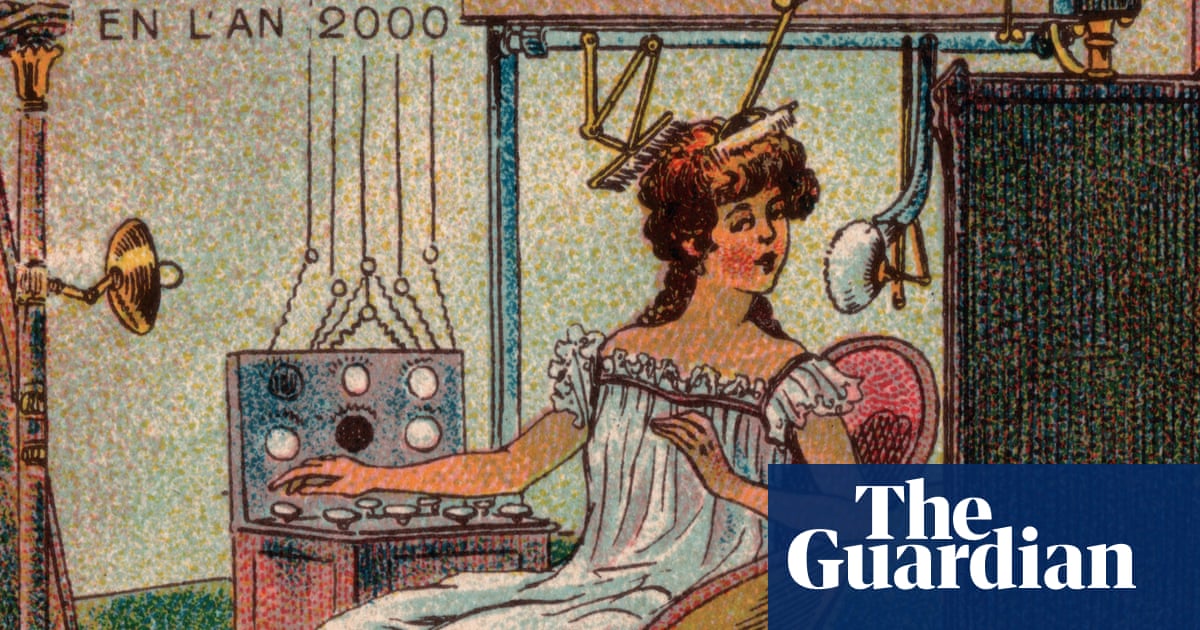“Things can only get better”, D:Ream promised, but they were wrong, and so were most people in history who have tried to predict the future.
It never stopped us from trying, though, and a few visionaries have been pretty good at it. There was Leonardo da Vinci, of course, with his helicopters and fridges, and Joseph Glanvill, who in 1661 suggested moon voyages and communication using “magnetic waves” might be a thing. Civil engineer John Elfreth Watkins, writing in 1900, predicted mobile phones, ready meals and global digital media (“Photographs will be telegraphed from any distance. If there be a battle in China a hundred years hence, snapshots of its most striking events will be published in the newspapers an hour later”). Visionary US cartoonist Arthur Radebaugh’s late 1950s and early 1960s Closer Than We Think series conjured wrist-worn TVs, robot-run warehouses and bloodless surgery.
They got plenty wrong, too: Watkins thought we’d be rid of mosquitoes and the letters C, X and Q; Radebaugh imagined hamster-wheel-style “uniwheel” cars and colonies of space monkeys. Many more futurists just added fanciful flourishes to recent technological developments – you need a hell of an imagination to conceive of a really different world.
That’s probably why some of the wilder ones happened in fiction. Jules Verne’s Paris in the Twentieth Century – written in 1860 but not published until 1994 – has everything from photocopiers and techno music to, er, people finding arts degrees ridiculous. HG Wells did even better (well, worse), imagining the atomic bomb.
What people predict inevitably says more about their hopes and fears than the actual future. Predictions proliferate around big dates and dramatic world events, and they mirror contemporary preoccupations. Rapid technological change in the 19th century created new anxieties as well as optimism and their imagined futures reflect that (women getting uppity is a bit of a recurring theme, too). Visions from the 1960s contain both space-age, sky’s-the-limit ebullience – we can do anything! – and cold war dread, searching for viable alternatives if nuclear annihilation made life on Earth impossible. Reality falls somewhere between the two, but I find the list of people who have been convinced the world is going to end by fire, flood, comet or antichrist on a specific date over the past 1,000 years oddly comforting. Take that, suckers: we’re still here (for now).
On which cheerful note, it’s time for some fanciful past futures. So hop off your hoverboard, ask your kangaroo butler to bring you a roast dinner pill and let’s get started.
The march of intellect, 1829
Progress looks incredible in cartoonist William Heath’s satire on it – far better than reality. There’s so much to enjoy: the mechanised steam mega-horse with smoking nostrils; the vacuum tube that transports you to Bengal; the airborne whale-gargoyle taking convicts to New South Wales in style; a dustman gnawing a whole pineapple; the stylishly winged post(Bat)man … I’m also bemused Heath thought future swans would be so benign that they would be amenable to being harnessed. I suppose that’s progress for you.
Test tube baby, 19th century
In his “20th century” trilogy, written in the 1880s and 90s, French author and illustrator Albert Robida imagined videoconferencing, the Ring video doorbell, a pneumatic-tube “hyperloop” train system, industrialised food production and a disgusting, polluted world where “our streams swarm with pathogenic ferments”. This test-tube baby is a little less on the nose, but I like the raddled-looking scientist who has cooked it up, clearly wishing he’d invented, say, ibuprofen instead.
Roofed city, 19th century
The German Hildebrands chocolate company’s trading cards of the future featured all sorts of marvels: buildings you could pull along on rails with steam engines, a water penny-farthing and summer holidays at the north pole – which, yes, unfortunately will also probably come true about 30 years from now. I don’t want to name names, but there are a few UK cities that would definitely benefit from a rainproof glass roof (cough, Manchester, cough).
Congestion, c1901-14
Visions of future transport often featured skies crammed with flying vehicles, but by and large road transport has remained boringly gravity-bound (a relief for anyone like me, who can barely manage a dual carriageway at ground level). Robida had a cooler version, with sleek-lined, almost animalistic sky vehicles. But I like the farcical impracticality of this blimp jam. You can tell it’s French from the gesture the man on the far left is making, which has been flung at me at many Gallic crossroads.
Bathroom, Year 2000, 1899
The Year 2000 images were commissioned from artist Jean-Marc Côté by a French toymaker for the 1900 Paris Exhibition, becoming famous when Isaac Asimov republished them in 1986. They’re all wonderful : underwater hippo and seahorse riding; a whale-drawn bus; a scientist examining vast, horrid-looking “microbes”. I’ve chosen this because it portrays exactly how I, the world’s laziest woman, wish my nightly ablutions to occur. Make it happen, science!
School, Year 2000, 1899
Another Year 2000 card, featuring a fairly bleak vision of future school. I like how the teacher isn’t even grinding up the collected works of Racine or Molière or whatever himself, but has outsourced it to child labour. Côté wasn’t the only one to think there were better solutions for education than trying to shove quadratic equations into Year 9 brains through sheer charisma: in the late 1950s, Arthur Radebaugh imagined each pupil plonked in front of a whirring, clicking many-buttoned machine, “so he could advance as fast as his abilities warranted”.
Metropolis, 1927
I find Fritz Lang’s vision of the future in his silent film Metropolis – set in the year 2000 – genuinely unsettling: the super-rich above, the grist-to-the-machine downtrodden workers below, the bit where – (spoiler alert for a 1927 film) a woman gets burned at the stake but is revealed to be a robot, argh. HG Wells called it “the silliest film” but he hadn’t met 2024.
Videophone, 1928
I’m not sure why France was at the forefront of imagining unnervingly accurate futures – other issues of Le Petit Inventeur feature sort-of solar panels and space flight – but here’s a nice French family from 1928 FaceTiming each other (“Vous êtes on mute!”).
Automated home, 1929
This blissful, if potentially noisy, vision reminds me of my heroine, Frances Gabe, who made the self-cleaning home a reality in the 1980s, when she turned her Oregon bungalow into, basically, a giant dishwasher. Sadly, apart from Gabe, few people have advanced this most necessary cause. I do have one of those little autonomous vacuum cleaners, but it has already developed consciousness (last week it told me it was “exploring”, brrr) and will soon make me do its cleaning. That’s the real future.
Playing games in self-driving car, 1957
Possibly the worst of all visions of the future here, where a self-driving car has forced this poor family to play a board game. Unbearable. Kitt from Knight Rider would never. Self-driving cars are pretty much upon us – soon drivers of a new BMW in Germany will be allowed to take their hands off the wheel – but if board games are part of the deal, I’m mirror, signal, manoeuvring till I die (under the merciless castors of my robot vacuum).
Underwater car, 1977
The past future’s obsession with transport is slightly boring; who cares about going places faster? I don’t want a jetpack – I want someone to bring those extinct 10ft-tall, two-ton sloths back from extinction. Anyway, here’s an underwater sports car from the James Bond film The Spy Who Loved Me. It was actually a functioning submarine, nicknamed Wet Nellie, which I suppose is sort of cool, but now it belongs to Elon Musk, which emphatically isn’t.







